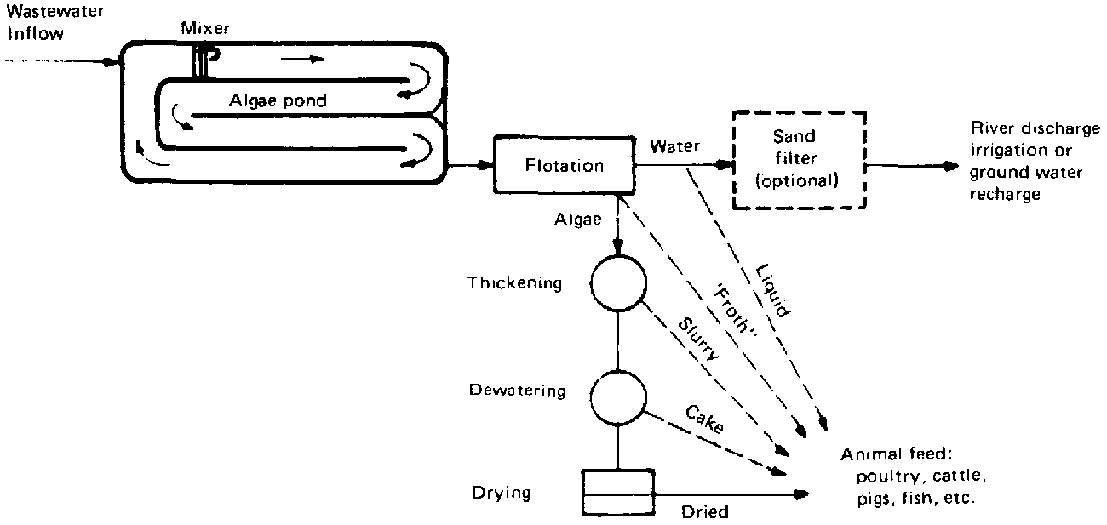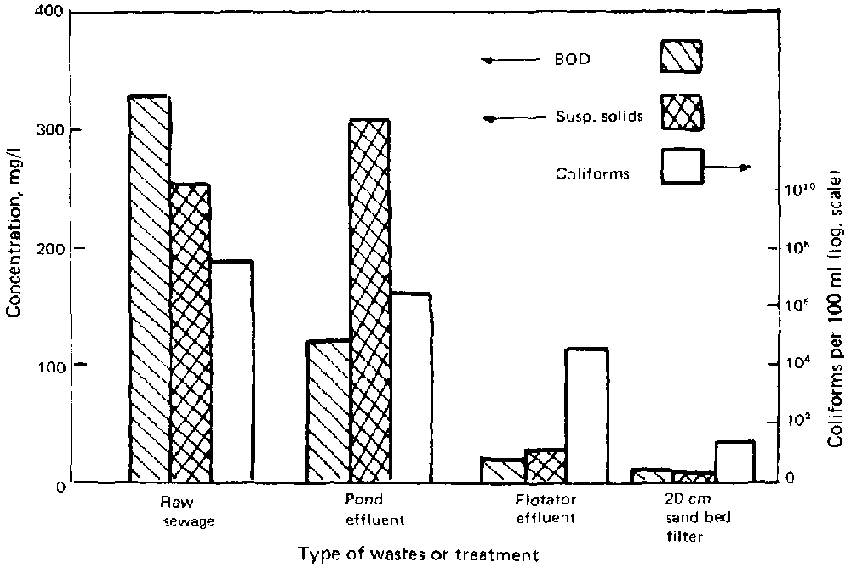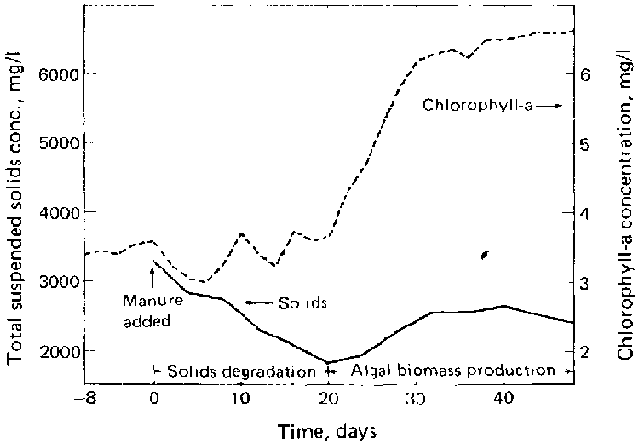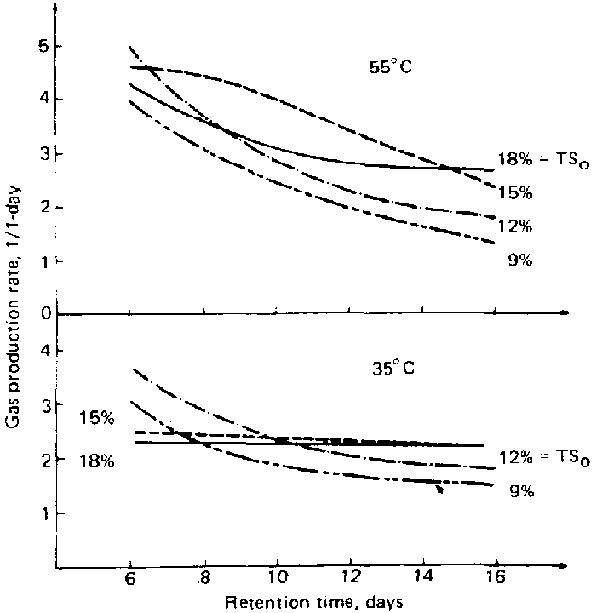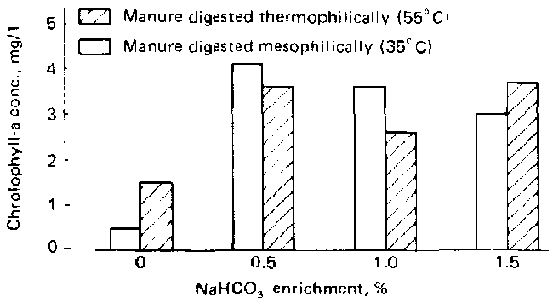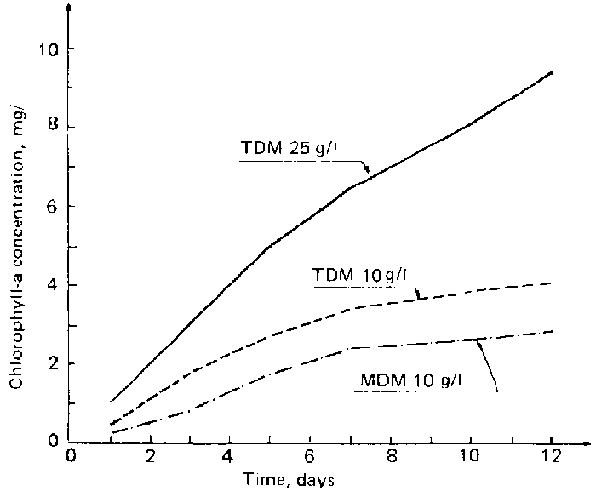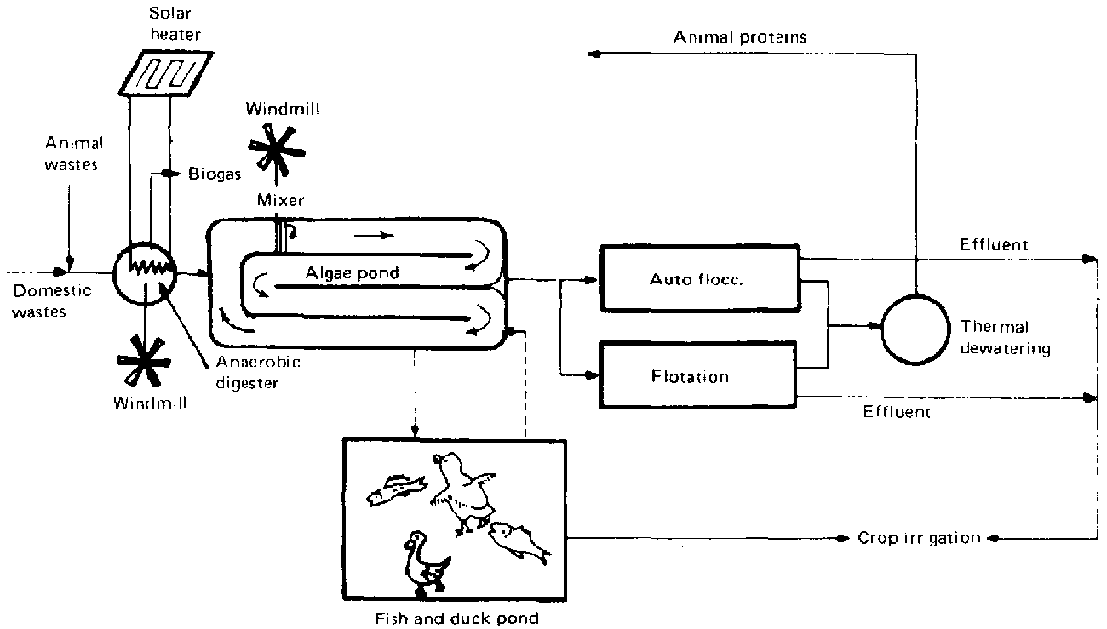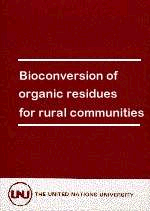
Bioconversion of Organic Residues for Rural Communities (UNU, 1979, 178 p.)
The combination of algal and anaerobic waste treatment in a bioregenerative farm system[edit | edit source]
Gedaliah Shelef
Department of Environmental and Water Resources Engineering, Technion - Israel Institute of Technology, Haifa, Israel
Introduction[edit | edit source]
The concept of the bioregenerative farm has been introduced to describe a model farm in developing countries (that can easily be applied in developed countries as well) where domestic and farm wastes are recycled and recovered to a maximum level through a chain of biological processes and farming practices, thus reducing input of cash-intensive items such as proteinaceous animal feed, irrigation water, fertilizers, and fuel, while increasing cash-intensive outputs such as animal products, fish, and cash crops (1). Enhancing sanitary and health conditions by proper waste management is an important fringe benefit of the bioregenerative farm concept, though not always fully appreciated. Once the concept of self-reliance in the farming community has been accepted, other non-biological resource recovery techniques, such as utilization of solar and wind energy, can be introduced as well.
The principal bioregenerative process discussed in this paper involves the intensive growth of algae on wastes, with an emphasis on its combination with anaerobic bacterial processes. Pond fish production can be tied to the bioregenerative scheme, as can other, though less well established, biological systems, such as nitrogen fixation by the blue-green alga Anabaena azolla, which is symbiotically associated with the Azolla fern in rice paddies, replacing commercial nitrogenous fertilizers (2).
All biological processes involved in the bioregenerative concept are well established in nature's cycles of organic matter degradation and primary productivity, and in the food chain. Within the bioregenerative farm they are, however, intensified many-fold and are designed to increase their biomass growth rate, and hence their activity, by optimizing the physical conditions and the growth-limiting factors such as substrate and nutrient concentrations, light intensities (in the case of algae), retention time, etc.
Some of the components of the bioregenerative farm considered for application in rural regions of developing countries stem from results and experiences accomplished by using sophisticated techniques, such as algal systems for life-support space applications (3), for food production (4), for treatment of municipal wastes (5), etc. The development of the Gobar anaerobic fermenter for rural areas in India benefited from decades of development of heated, mechanically mixed, continuous anaerobic digesters of municipal waste-waterborne sludges
Some famous racing-car manufacturers who later turned to the production of less complex, popular, inexpensive cars have learned that simple technologies can benefit greatly from experience with complicated ones. Or, as illustrated by an advertising slogan of a large US corporation that was involved in the space programme, but has now turned to manufacturing consumer products as well: "... it took putting a man on the moon to produce a reliable coffee-maker ...."
Indeed, a significant part of the information that is being used now to develop the bioregenerative farm concept comes from two major comprehensive projects carried out at the Technion Environmental Engineering Laboratories in Haifa, planned for communities in industrialized countries using more sophisticated techniques and methodology The first is the joint Israeli-German project on Combined Algal Municipal Waste Water Treatment, Water Reclamation, and Animal Protein Production (6), and the second is the project on Utilization of Agricultural Wastes for the Anaerobic Production of Biogas, which has been sponsored by the Kibbutz Industry Association of Israel since 1975, and whose goal is to accomplish a maximum degree of self-reliance in energy through biogas production and utilization in the kibbutz-type communal, highly modernized farming system (7, 8). The relevant information from both projects, together with results of experiments directly related to the bioregenerative farm in developing countries, are discussed in this paper.
Algae production on organic wastes[edit | edit source]
High-Rate Algal Systems for Municipal Waste-Water Treatment
The treatment of municipal waste water in shallow (less than 50 cm deep), mechanically mixed, meandering (folded) channels was first proposed and demonstrated by Oswald and Golueke (9) in California. It was later studied by McGarry et al. (10) in Thailand, by Goldman and Ryther (11) in Woods Hole, Massachusetts, and by Benemann et al. (12) in California, and has been further developed by Shelef et al. (13, 14) in Israel.
Experiments at the Technion Environmental Engineering Research Center ranged from laboratory and pilot plant studies to field-scale studies in ponds of 1,000 m² each, one of which at Haifa Bay is illustrated in Figure 1.
The flow scheme of this system is shown in Figure 2, where raw municipal sewage is continuously introduced to the photosynthetic pond with an average retention time of three days, depending on climatic conditions. The effluent of this pond, which contains between 300 to 500 mg/l suspended matter, mostly algal biomass (approximately 60 per cent) and bacterial biomass (approximately 35 per cent), is treated physico-chemically, using aluminum sulphate (alum) flocculation and dissolved air flotation.
Figure. 2. Flow Scheme of the Accelerated Photosynthetic Process for Waste-Water Treatment and Algal Protein Production
The flotation unit, with a surface flow-through rate of between 4 and 6 m hr(-1), separates the algal bacterial biomass, yielding a treated effluent with average quality characteristics summarized in Table 1 and illustrated in Figure 3. This effluent has a quality adequate for use as irrigation water for most agricultural crops, or for discharge into most receiving bodies of water.
Figure. 3. Enhancement of Effluent Quality in Various Treatment Steps of the Accelerated (High Rate) Algal Process
TABLE 1. Effluent Quality from Various Stages of the Accelerated Photosynthetic WasteWater Treatment Process (under Favourable Operational Conditions)
|
Effluent characteristic |
Raw sewage |
Pond effluent |
Flotator clarified effluent |
30 cm sand filtrate |
| BOD total, mg/l | 330 | 120 | <25 | <10 |
| BOD dissolved, mg/l | - | - | <10 | <10 |
| COD total, mg/l | 750 | 450 | 140 | 110 |
| COD dissolved, mg/l | - | 120 | 90 | 85 |
| Suspended solids, mg/l | 260 | 300 | <25 | <10 |
| Ntotal, mg/l | 80 | 45 | 25 | 20 |
| Ndissolved (NH3) mg/l | - | 20 | 18 | 18 |
| Ptotal, mg/l | 15 | 12 | <2 | <1 |
| Coliforms/100 ml | 108 | 106 | 104 | <10² |
By additional slow sand filtration through a 30 cm-deep sand bed, followed by disinfection by chlorination, the effluent is adequate for irrigation of all agricultural crops, including/hose edible in raw form, for discharge into virtually all surface receiving bodies of water, and for ground-water recharge.
The separated algal-bacterial biomass, in the form of "froth" containing between 4 and 5.5 per cent solids, is skimmed off, thickened by inverted decantation to a slurry of between 7 and 9 per cent solids, further dewatered to a light cake of between 14 and 18 per cent solids, and then steam drum-dried to form dry flakes or powder that can be pelletized with other feed ingredients.
The biomass production, as well as other characteristics of the system, serving, for example, a city of 100,000 inhabitants living in climatic conditions simian to those near Haifa Bay, are given in Table 2.
TABLE 2. Summary of Algae Production Data Based on Technion Pilot Plant and Field-Scale Pond Operation
| Total net biomass yield (dry) | 155 tons/ha-year |
| Average daily total biomass production (dry) | 42.59/m²-day |
| Per cent algae in biomass | 57 |
| Algal biomass yield (dry) | 88 tons/ha-year |
| Average daily algal biomass production (dry) | 24.29/m² day |
|
Pond area requirement for city of 100,000 inhabitants under Eastern Mediterranean climatic conditions (assuming waste- water flow of 200 litres per capita per day) |
13.3 ha |
| Total yield (dry) per city | 2,060 tons/year |
| Total protein yield (43% dry matter) | 886 tons/year |
| Average daily incident irradiance (total) | 450 cal/cm²-day |
| Average daily incident photosynthetically available irradiance | 202 cal/cm² day |
|
Photosynthetic light conversion efficiency (based on total irradiance) |
2.96% |
|
Photosynthetic light conversion efficiency (based on photo- synthetically available irradiance) |
6.59% |
|
Maximum possible light conversion efficiency (based on photosynthetic available irradiance) |
- 12% |
| Percentage of light conversion attained vs. potential | 55% |
The effluent, containing algal-bacterial biomass suspension, can be used directly to feed fish ponds, and yields of Tilapia galilea (St. Peter's fish) of over 7 tons per hectare were achieved in field experiments by Hepher and Sandbank (15). The flotator concentrate, after further thermal dewatering, can be mixed directly with other ingredients and used for semi-wet feeding of cattle and poultry (16). Sun-drying of the dewatered material is practical, preferably when dried over beds containing ground corn, soymeal, and wheat, which are components of the animal feed ration. Because preservation of the wet biomass for more than 48 hours is problematic, wet feeding is possible only when the farm animals are in close proximity to the photo synthetic waste water treatment plant. That is why most of the nutritional and feeding tests were performed with pelletized, drum-dried algal biomass. Extensive feeding experiments with broiler chicks and laying hens (17, 18) showed conclusively that between 25 and 50 per cent of the soymeal portion in the feed rations could be replaced with dried algal biomass, with no change in growth characteristics, weight gain, egg production, or the general welfare of the animals compared to animals fed feedmeal based on soymeal as the principal source of protein. An added benefit of the carotenoid-rich algae feeding was the "healthy" colour of the egg yolk.
Large-scale feeding experiments in intensive, mechanically aerated fish ponds stocked with carp (Cyprinus carpio) and St. Peter's fish (Tilapia galilea) were performed by Hepher and Sandbank 115) using pelletized feed containing approximately 22 per cent of drum-dried algal biomass, replacing on an equal protein basis all the fish meal in the ration (usually 15 per cent of the commercial ration). Fish growth rate, weight gain, and general welfare have been found conclusively to be equal to, and in most cases significantly better than, in fish fed fishmeal-based ration, with yields of between 15 and 20 tons per hectare per year of fish.
Extensive organoleptic and toxicological tests were performed on this material by Yannai et al. (19), using alum flocculated algae. The algae, although containing aluminum and wastewater-borne heavy metals, showed no adverse effects when fed to chickens or to rats fed on the chicken's meat, and no accumulation of these metals was noticed in the animal's meat or other organs. No abnormal taste or odour was noticed in organoleptic tests of algae-fed chicken or fish.
The economics of the combined waste-water treatment, water reclamation, and protein production photosynthetic system is extremely favourable (14), based on the various benefits simultaneously gained by the system - namely: (a) waste-water treatment with lower energy requirements for mechanical aeration, (b) the value of the high quality effluent for irrigation, and (c) the value of the proteins for animal feeding.
Conservatively, subtracting the benefits of waste-water treatment and reclamation results in a net cost for dried algae of less than US$140 per ton, compared to more than US$200 per ton for soymeal and more than US$380 per ton for fishmeal.
The Growth of Algae on Animal Wastes
Animal wastes constitute an excellent medium for growing algae when diluted with water, and they provide a carbon source (through bacterial aerobic degradation that produces CO2), nitrogen, phosphorus, and trace elements to sustain rich algae production.
On small farms in developing countries, where algae separation and processing are too complicated and costly, the growth of the blue-green Spirulina algae is preferred over green algae for the following reasons: (a) mechanical separation by straining or filtration is possible; (b) protein content is high (55 - 70 per cent); and (c) protein digestibility and availability are high.
Under conditions in small rural communities in developing countries, these advantages surpass the disadvantages of Spirulina compared with green algae (Chlorophytee). The disadvantages include: reduced rate of growth, need for higher temperature, need for relatively high concentrations of bicarbonates or carbonates, and sensitivity to high irradiance levels. Growing Spirulina on animal wastes has been studied experimentally under the conditions prevailing in developing countries by Seshadri (20) in India, Soong (21) in Taiwan, and others Two sets of experiments testing Spirulina growth potential on animal wastes are described herein, one on raw (fresh) cow manure and the other on anaerobically digested cow manure.
Growth potential of Spirulina on raw cow manure
Experiments on the growth potential of Spirulina maxima under outdoor conditions in shallow (20 cm) multiple batch-type 200-litre "mini-ponds" have been performed at the Technion Institute in Haifa.
Five kg of wet, raw (fresh) dairy cow manure from Kibbutz Yagur with a total solids content of 16 per cent were added to each 200-litre mini-pond in order to reach initial solids concentration of 0.4 per cent (25 9/l) based only on the added manure and excluding the initial algae concentration of approximately 200 mg/l.
The composition of the raw manure and the concentration of its various components after the manure was added to the 200-litre mini-ponds are given in Table 3. It should be noted that the composition of the manure in Table 3 includes both the suspended and the dissolved matter of the wet manure fed into the mini-ponds.
TABLE 3. Composition of Raw Cow Manure Used for Growth of Spirulina maxima
| Component |
Raw cow manure (wet basis) g/kg |
Concentration at 1:40 dilution in mini-pond' (mg/l) |
| Total solids | 166 | 4,150 |
| Total volatile solids | 135 | 3,380 |
| COD total | 155 | 3,880 |
| Total Kjeldahl nitrogen | 5.3 | 130 |
| Ammonia nitrogen | 1.6 | 40 |
| Total phosphate as PO4 | 4.1 | 100 |
| Volatile acids | 10.2 | 260 |
| pH | 7.2** | 9 - 11** |
* Components of stock algae culture are excluded.
** Dimensionless
Two weeks before the addition of the manure, the mini-ponds were inoculated with Spirulina maxima that had been isolated from domestic waste-water treatment ponds (the latter ponds were inoculated with Spirulina a few years ago). The initial medium was a synthetic one enriched with 16 g/l of sodium bicarbonate. The temperature of the mini-ponds was maintained at 30 C, and the ponds were continuously stirred by a long-winged rotor (6). The concentration of Spirulina before the addition of the manure was approximately 200 mg/l, and the chlorophyll-a concentration was approximately 3.5 mg/l. The changes in suspended solids concentration and in chlorophyll-a are given in Figure 4.
Figure. 4. Chlorophyll-a and Suspended Solids Concentrations in Batch-Type 200-litre Spirulina maxima Outdoor Mini ponds Fed with Raw Cow Manure
Following the addition of the manure, chlorophyll-a concentration was reduced by 20 per cent, and for approximately 20 days algal growth was almost negligible. It should be noted that the addition of 5 kg wet, raw manure to the 200-litre mini-ponds created highly stressed conditions as far as organic loading and turbidity were concerned, and the ponds became turbid and brown. During the initial 20 days, intensive degradation of the manureborne organic matter and solids occurred, evident in the reduction of solids concentration.
Spirulina grew rapidly between the twentieth and thirtieth days, as revealed by rises both in chlorophyll-a and suspended solids concentration. After 30 days, algal concentration stabilized and a small reduction in suspended solids was observed after 40 days; this reduction was not followed by a reduction in chlorophyll concentration, which might have been due to the continuing increase in chlorophyll-a content of the alga.
No direct measurement of Spirulina biomass production was possible because of the presence of manure-borne suspended matter and the bacterial biomass developed during the degradation of the manure. Algal growth was therefore estimated by the increase in concentration of chlorophyll-a, which is a rather poor indicator of algal biomass because the chlorophyll content varies according to growth conditions, light availability, etc. Depending on conditions, chlorophyll-a content can range between 0.5 and 2.5 per cent in blue-green algae (22), and between 1 and 2.5 per cent in Spirulina grown in outdoor mass cultures (23). The chlorophyll-a content of the Spirulina maxima prior to the addition of the cow manure was approximately 1.75 per cent, and assuming that its percentage remained the same, Spirulina concentration reached 370 mg/l at the end of the experiment.
The growth of Spirulina following the addition of cow manure was therefore quite slow, but this can be explained by the high initial dose of raw manure. During the manure degradation period, algal growth was minimal, indicating the advantage of using treated manure (composted or digested) as an algae growth medium.
Growth potential of Spirulina on digested manure
Following the experiments described above, anaerobically digested cow manure from mesophilic (35°C) and from thermophilic (55°C) mixed, semi-continuously fed digesters with a retention time of eight days was used as a medium in batch, continuously illuminated, 500 ml laboratory algae growth units. The production of biogas (approximately 65 per cent methane) during the thermophilic and mesophilic anaerobic digestion of the cow manure (24) as a function of retention time and at various concentrations of total solids is given in Figure 5.
Figure. 5. Biogas Production Rate from Thermophilic (55°C) and Mesophilic (35°C) Digestion as a Function of Retention Time and Feed Total Solids (TSo) Concentration (24)
The digested matter, with approximately 16 per cent total solids, of which approximately 30 per cent of volatile solids had been destroyed during the anaerobic digestion, was mixed with the sodium bicarbonate-enriched medium at dosages of 10 and 25 g of wet, digested manure per litre of medium. The medium was inoculated with 5 ml of Spirulina maxima concentrated suspension.
Enrichments with 0.5, 1.0, and 1.5 per cent NaHCO3 in the medium were compared to growth units with no enrichment. The concentration of chlorophyll-a after ten days of algal growth, fed with 10 9/l of both mesophilically and thermophilically digested manures, is given in Figure 6.
Figure. 6. Chlorophyll-a Concentration Following Ten Days, Growth of Spirulina maxima in Batch Continuously Illuminated Laboratory Growth Units, Fed 10 Grams (Wet) per Litre of Anaerobically Digested Manure
No marked effect on Spirulina growth was observed by increasing NaHCO3 enrichment above 0.5 per cent, nor have the temperatures of the anaerobic digestion (55 C vs. 35 C) of the feed had a significant effect on Spirulina growth, as evident from the concentration of chlorophyll-a.
The effect of the dosage of digested manure is given in Figure 7, where dosages of 10 and 25 9 of wet, digested manure per litre of alga culture were compared.
Figure. 7. The Effect of Digested Manure Dosage on Chlorophyll-a Concentration in Batch Laboratory Culture of Spirulina maxima (TDM denotes thermophilically digested manure, and MDM-mesophilically digested manure.) Concentrations of digested manure are in grams (wet) per litre of growth unit.
The higher digested manure dosage, which was similar to the raw manure dosage described earlier, gave the highest increase (up to 9.3 mg/l after 12 days) in chlorophyll-a concentration. Assuming average concentrations of 1.75 per cent of chlorophyll-a in Spirulina (dry basis), an algal concentration of over 510 mg/l was achieved in 12 days. The limitations of chlorophyll-a as a reliable quantitative measurement of algal biomass production have been discussed previously.
No appreciable lag time was observed in these experiments, and no time requirement for organic matter degradation (which was particularly evident in the experiments with raw manure) was found. Obviously, the production of biogas during anaerobic digestion is an important added benefit to the production of Spirulina Combined System for Algae Production and Anaerobic Digestion.
Following the previously discussed experiments showing the potential of algal growth on anaerobically digested manure, a combined "sandwich" system was developed whereby anaerobic digestion of farm organic residues takes place at the bottom part (gas is collected by a bell-shaped dome), while the digester's supernatant directly feeds the algal pond at the upper part of the system. A small pilot plant outdoor system with a 100-litre digester and a 2.7 m² algal pond (35 cm deep) was recently set up at the Technion Institute and is now under study. Preliminary results show a production of 50 litres of biogas (STP) per day and a total biomass production (approximately 67 per cent algae) of 130 g/day (dry basis). A solar panel has recently been installed to heat the digester part of the system to approximately 37°C (mesophilic) to increase gas production rates.
A small windmill is under design to provide driving force for digester and pond mixing and for the outflow pump.
The bioregenerative farm[edit | edit source]
Following the experiments described above, a conceptual design of a bioregenerative farm based on the utilization of wastes from 5 adult humans, 12 cows, 30 pigs, and 2,000 hens was developed. The quantities of wastes, volatile matter, expected biogas production, gross energy output, and nitrogen and phosphorus content are given in Table 4. It should be noted that the human wastes contain both liquid (sewage) and solids (garbage). Conditions in both developing countries (a) and developed countries (b) were assumed regarding the quantities and composition of wastes as well as the degree of volatile solids destruction (25 per cent and 30 per cent, respectively). Mesophilic digestion with 12 days average retention time was assumed for developing countries, yielding a digester with a net liquid volume of 17.5 m³, while a thermophilic digester with 8 days retention and 28 m³ (liquid) volume is assunied for developed countries. Waste matter mixture fed into the digesters contains 6.6 per cent volatile solids in the developing countries, and 4 per cent in the developed, with gross energy outputs of 0.1 and 0.2 million kcal per day in the developing and developed countries, respectively.
TABLE 4. Material and Energy Balances of the Anaerobic Digestion Part of a Model Bioregenerative Farm under Conditions of Developing Countries (a) and Developed Countries (b)
| Source of wastes | Volume per day* | Volatile solids kg (dry) per day | Biogas production m³ (STP) per day** | Energy production (gross) 10³ kcal/day*** | Nitrogen kg-N/day range | Phosphorus content kg-P/day range | ||||
| a | b | a | b | a | b | a | b | |||
| 5 humans (liquid and solid waste) | 0.56 | 1.00 | 2.8 | 5.6 | 0.58 | 1.40 | 3.3 | 7.9 | 0.1 - 0.3 | 0.013 - 0.05 |
| 12 cows | 0.10 | 0.50 | 19.2 | 60.0 | 3.95 | 14.80 | 22.5 | 84.4 | 0.5 - 2.7 | 0.09 - 0.20 |
| 30 pigs (75 kg each) | 0.71 | 1.84 | 35.4 | 35.4 | 7.28 | 8.74 | 41 5 | 49.8 | 1.9 - 3.2 | 0.2 - 0.6 |
| 2,000 hens (2 kg each) | 0.08 | 0.12 | 38.0 | 38.0 | 7.82 | 9.38 | 44.6 | 53.5 | 1.4 - 2.9 | 0.4 - 0.9 |
| TOTAL | 1.45 | 3.46 | 95.4 | 139.0 | 19.63 | 34.32 | 111.9 | 195.6 | 3.9 - 9.1 | 0.70 - 1.75 |
* Average data for developing countries la) and developed countries (b).
** Assuming 25 per cent of volatile solids converted to biogas in developing countries and 30 per cent conversion in developed countries with 0.823 litres (STP) of gas produced per gram of volatile solids destroyed.
*** Assuming 60 per cent methane in biogas with an energy content of 5700 kcal per m³ (STP) of biogas.
Not only will this energy production enable the farm household to become self-sufficient in energy, but surplus energy is provided for such purposes as water pumping, algal thermal treatment, digester heating, crop drying, small agro-industry, etc. Solar heating of the digester and wind-driven mixing and pumping can further reduce energy requirements and increase net energy surplus.
The digester's supernatant is diluted to provide an effluent with a concentration of 750 mg/l volatile solids to be fed to algal photosynthetic ponds. This diluted liquid medium contains the bulk of the nutrients (primarily nitrogen and phosphorus) as well as an ample carbon source in the form of organic carbon, dissolved CO2, and bicarbonates.
Table 5 summarizes the data of an algal pond model under conditions of both developing and developed countries under proper climatic conditions. It can be seen that the area for the ponds is 1,200 m² in developing countries and 1,620 m² in developed countries, yielding 45.4 and 61.6 kg per day of dry biomass, respectively, with an average protein content of 42 per cent. This yield of biomass can provide the major source of the farm animals' protein requirements through recycling. The pond effluent, following algal biomass separation, can be used for fish ponds, crop irrigation, or diluting the digester's supernatant.
TABLE 5. Summary of Parameters for the Biomass Production Part of the Model Bioregenerative Farm
|
Developing country |
Developed country | |
| Daily quantity of digested volatile solids | 71.5 kg | 97 kg |
| Daily volume of digested material | 1 45 m³ | 3.46 m³ |
| Dilution factor | 65 | 37.4 |
| Volume of wastes diluted to 750 mg/l volatile solids | 95 m³/day | 130 m³/day |
| Photosynthetic (algal) pond retention time | 5 days | 5 days |
| Pond's depth | 0.4 m | 0.4 m |
| Pond's area | 1,200 m² | 1,620 m² |
| Algal biomass production (net) | 22 g/m²/day | 22 g/m²/day |
| Total daily net algal biomass production (dry) | 26.4 kg/day | 35.6 kg/day |
| Daily production of non-algal biomass (200 mg/l) | 19.0 kg | 26.0 kg |
| Total daily biomass production (dry) (algal and non-algal) | 45.4 kg | 61.6 kg |
| Total daily protein production(dry) (assuming 42% in biomass) | 19 kg | 36 kg |
Separation of the algal-bacterial biomass can be done by auto-flocculation (increasing pH by intensive exposure to sun-light in a shallow pond) or by alum flocculation-flotation. Thermal treatment of the algae slurry is recommended to provide pasteurization and partial dewatering.
Figure 8 illustrates schematically a conceptual bioregenerative farm where animal and domestic wastes are treated in a solar-heated, windmill-driven mixed biogas digester. The digester's supernatant feeds an algal photosynthetic pond from which proteinaceous biomass is produced for animal feeding and treated effluent is reclaimed for irrigation. A cycle combining the algal pond with a fish and duck pond is proposed as well. The scheme of Figure 8 shows a physical separation between the anaerobic digester and the photosynthetic pond; however, the combination of the two as in the "sandwich" design is possible and even advantageous.
Figure. 8. Schematic Layout of the Bioregenerative Farm Concept
Past experience with both anaerobic digestion and algal biomass production can provide the necessary design criteria and the data for material and energy balances of such a combined system. Nevertheless, actual demonstrations in various climates, using different farming practices and in various socio-economic settings in both developing and developed countries, under full-scale farm unit conditions, are required and recommended in order to prove and establish the complete design criteria for such a bioregenerative system, thus bringing about maximum self-reliance and self-sufficiency of the farming communities in the developed and developing countries.
References[edit | edit source]
1. G. Shelef, "The Bioregenerative Farm Concept," a special report to the United Nations University, Tokyo, Japan, 1977.
2. J.W. Newton, "Photoproduction of Molecular Hydrogen by a Plant-Algal Symbiotic System," Science, 191: 559 (1976).
3. G. Shelef, W.J. Oswald, and P.H. McGauhey, "Algal Reactor for Life Support Systems," J. Sanit. Engin. Div., Amer. Soc. Civil Engin., 96, No. 7105: 91-110 11970).
4. C.J. Soeder, "Zur Verwendung von Mikroalgen fur Ernahrungszwocke," Natur-wissenschaften, 63: 131 - 138 (1976).
5. G. Shelef, R. Moraine, A. Meydan, and E. Sandbank, "Combined Algae Production: Wastewater Treatment and Reclamation Systems," in H. G. Schiegel and J. Barnea (eds.), Microbial Energy Conversion, (Erich Goltze KG, Gottingen, 1976), pp. 427-442. 6. G. Shelef et al., "Combined Systems for Algal Wastewater Treatment and Reclamation and Protein Production," 2nd Progress Report, Technion Res. Devel. Found., Haifa, Israel, 1978.
7. I Rousseau, U. Marchaim, and G.A. Shelef, "System for the Utilization of Agricultural Wastes in an Agro-Industrial Settlement - Kibbutz as a Model," Resource Recov. Cons., 3: 217 (Elsevier Sci. Pub., 1979).
8. G. Shelef, S. Kimchie, U. Marchaim, and H. Grynberg, "Highly Loaded Anaerobic Digestion of Agricultural Organic Wastes," Proc. 10th Israel Ecol. Soc. Conf., 1979, pp. E17 - 39.
9. W.J. Oswald and C.G. Golueke, "The High-Rate Pond in Waste Disposal," Devel. Indust Microb., 4: 112-119 (1963).
10. M.G. McGarry and Tongkasame, "Water Reclamation and Algae Harvesting," J. Water Poll. Cont. fed., 43: 824 - 835 (1971).
11. J.C. Goldman and J.H. Ryther, "Nutrient Transformation in Mass Cultures of Marine Algae," J. Environ. Engin. Div., Am. Soc. Civil Engin., 101: EE3, 351 - 364 (1975).
12. J.R. Benemann, J.C. Weissman, B.L. Koopman, and W.J. Oswald, "Energy Production by Microbial Photosynthesis," Nature, 268: 19-23 (1977).
13. G. Shelef, R. Moraine, and G. Oron, "Photosynthetic Biomass Production from Sewage," Arch. Hydrobiol. Beih., 11: 3 - 14 (1978).
14. G. Shelef, G. Oron, and R. Moraine, "Economic Aspects of Microalgae Production on Sewage," Arch. Hydrobiol. Beih., 11: 281 - 294 (1978).
15. B. Hepher, G. Sandbank, and G. Shelef, "Alternative Sources for Warmwater Fish Diets," Proc. Internat Symp. Fish Nutr. and Feed Tech., EIFAC Symp. R/11.2, Hamburg, 1978.
16. H. Tagari, "Feeding of Ruminants with Wet Digested Slurry," 5th Prog. Report on Utilization of Animal Wastes, Kibbutz Indust. Assoc., Tel-Aviv, Israel, 1978.
17. S. Mokady, S. Yannai, P. Einav, and Z. Berk, "Nutritional Evaluation of the Protein of Several Algae Species for Broilers," Arch. Hydrobiol. Beih., 11: 89 - 97 (1978).
18. S. Hurwitz and B. Lipstein, "The Nutritional Value of Algae for Poultry," Final Report, Israel Nat. Coun. Res. Develop., Jerusalem, Israel, 1978.
19. S. Yannai, S. Mokady, K. Sachs, and Z. Berk, "The Safety of Several Algae Grown on Wastewater as Feedstuff for Broilers," Arch. Hydrobiol. Beih., 11: 139 - 149, 1978.
20. C.V. Seshadri, "Analysis of Bioconversion Systems at the Village Level," in this volume.
21. P. Soong, "Production and Development of Chlorella and Spirulina in Taiwan," Proc. Int. Symp. on Production and Use of Micro-Algae Biomass, Acre, Israel, Nat. Counc. Res. Develop, Jerusalem, Israel, 1978.
22. A. Konopka and T.D. Brock, "Changes in Photosynthetic Rate and Pigment Content of Blue-Green Algae in Lake Mendota," Appl. Environ. Microbiol., 35: 527 - 532 (1978).
23. E. Tel-Or, S. Boussiba, and A.E. Richmond, "Products and Chemicals from Spirulina platensis," Proc. Int. Symp. on Production and Use of Micro-Algae Biomass, Acre, Israel, Nat. Counc. Res. Develop., Jerusalem, Israel, 1978
24. G. Shelef, S. Kimchie, H. Grynberg, and U. Marchaim, "Intensified Thermophilic Anaerobic Digestion of Agricultural Wastes," J. Biotech. Bioengin., 1979 (in press).
Discussion summary[edit | edit source]
It was asked whether any attempt had been made to concentrate algal slurry by winddriven centrifuges. This method would be too expensive in Israel. Others wondered about seasonal variations in the toxicological and nutritional characteristics of the algae, and were assured that these could be controlled by causing a single species of known toxicological and nutritional characteristics to become dominant. This may be done by selecting the appropriate conditions of loading and retention times in the ponds.
There was the suggestion that membrane separation might well be feasible at the present time. In reply to a question on the stability and reproducibility of the process, it was stated that the system had worked satisfactorily in both summer and winter over a period of three years.
